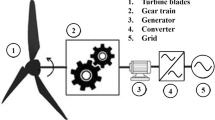Abstract
In this paper, the author investigates an experimental wind turbine emulator linked to a transmission line model 380 kV. Before presenting and analyzing the experimental results that deals with the voltages, the Ferranti effect, the active and the reactive powers at the sending end and the receiving end with different kinds of loads, the author presents firstly a theoretical study dealing with the model of the wind turbine, the salient synchronous generator and the transmission line. The Ferranti effect and the power analysis are also presented. Theoretical study and experimental results are benefits and advantageous.














Similar content being viewed by others
References
Lopesa FV, Küsel BF, Silva KM, Damasio F Jr, Neves WLA (2014) Fault location on transmission lines little longer than half-wavelength. Electr Power Syst Res 114:101–109
Eminoglu U, Hocaoglu MH (2005) A new power flow method for radial distribution systems including voltage dependent load models. Electr Power Syst Res 76:106–114
Gatta FM, Geri A, Lauria S, Maccioni M (2011) Steady-state operating conditions of very long EHVAC cable lines. Electr Power Syst Res 81:1525–1533
Benato R, Paolucci A (2008) Operating capability of ac EHV mixed lines with overhead and cables links. Electr Power Syst Res 78:584–594
Benato R, Paolucci A (2005) Operating capability of long AC EHV transmission cables. Electr Power Syst Res 75:17–27
Gatta FM, Lauria S (2005) Very long EHV cables and mixed overhead-cable lines. Steady-state operation. In: Proceedings of IEEE St. Petersburg power Tech’05 conference, St. Petersburg, Russia, June 27–30
Rendina R, Posati A, Rebolini M, Bruno G, Bocchi F, Marelli M, Orini A (2006) The new Turbigo-Rho 380 kV transmission line: an example of the use of underground XLPE cables in a meshed transmission grid. In: CIGR’E, p B1-301
Rodrıguez G, Aromataris L, Donolo M, Hernandez J, Moitre D (2003) Software for calculation of electric power systems parameters. Comput Electr Eng 29:643–651
Petcharaks N, Yu C, Panprommin C (1999) A study of Ferranti and energization overvoltages case of 500 kV line in Thailand. High Volt Eng 1999. In: 11th International symposium on, 1:291–294, London, 23 Aug 1999–27 Aug 1999
Salcedo R, Ran X, de León F, Czarkowski D, Spitsa V (2013) Long duration overvoltages due to current backfeeding in secondary networks. IEEE Trans Power Delivary 28(4):2500–2508
Deraz SA, Kader FEA (2013) A new control strategy for a stand-alone self-excited induction generator driven by a variable speed wind turbine. Renew Energy 51:263–273
Pichan M, Rastegar H, Monfared M (2013) Two fuzzy-based direct power control strategies for doubly-fed induction generators in wind energy conversion systems. Energy 51:154–162
Pande VN, Mate UM, Kurode S (2013) Discrete sliding mode control strategy for direct real and reactive power regulation of wind driven DFIG. Electr Power Res 100:73–83
Urtasun A, Sanchis P, San Martín I, López J, Marroyo L (2013) Modeling of small wind turbines based on PMSG with diode bridge for sensorless maximum power tracking. Renew Energy 55:138–149
Alaboudy AHK, Daoud AA, Desouky SS, Salem AA (2013) Converter controls and flicker study of PMSG-based grid connected wind turbines. 4(1):75–91
Bulic N, Sumina D, Miskovic M (2010) A comparison of advanced control structures for synchronous generator excitation control. Int Rev Electr Eng (IREE) 5(2) part A:473–480
Hidouri N (2014) Power control applied to a grid connected fuzzy-MPPT-controlled photovoltaic system. Int J Energy Convers (IRECON) 2(2):40–48
Hidouri N (2014) A fuzzy controlled scheme for an isolated hybrid MPPT-photovoltaic diesel-PMSG system. Int Rev Electr Eng (IREE) 9(2):290–299
Hidouri N, Hammadi S, Sbita L (2012) An advanced DPC-self excited induction generator drive scheme for an isolated wind turbine boost system. Int Rev Modell Simul (IREMOS) 5(2):913–920
Author information
Authors and Affiliations
Corresponding author
Rights and permissions
About this article
Cite this article
Hidouri, N. An efficiency experimented wind turbine emulator linked to transmission line model 380 kV. Electr Eng 100, 129–137 (2018). https://doi.org/10.1007/s00202-016-0486-y
Received:
Accepted:
Published:
Issue Date:
DOI: https://doi.org/10.1007/s00202-016-0486-y




